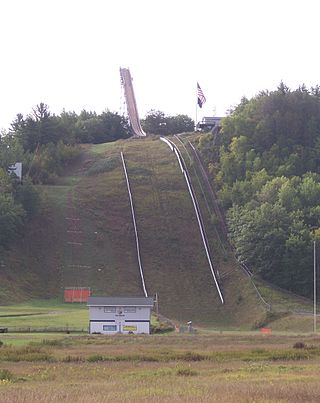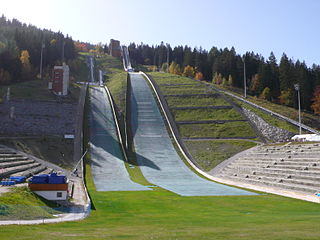
Ski jumping is a winter sport in which competitors aim to achieve the farthest jump after sliding down on their skis from a specially designed curved ramp. Along with jump length, competitor's aerial style and other factors also affect the final score. Ski jumping was first contested in Norway in the late 19th century, and later spread through Europe and North America in the early 20th century. Along with cross-country skiing, it constitutes the traditional group of Nordic skiing disciplines.

Holmenkollbakken is a large ski jumping hill located at Holmenkollen in Oslo, Norway. It has a hill size of HS134, a construction point of K-120, and a capacity for 70,000 spectators. Holmenkollen has hosted the Holmenkollen Ski Festival since 1892, which since 1980 have been part of the FIS Ski Jumping World Cup and 1983 the FIS Nordic Combined World Cup. It has also hosted the 1952 Winter Olympics and the FIS Nordic World Ski Championships in 1930, 1966, 1982 and 2011.

The FIS Ski Jumping World Cup is the world's highest level of ski jumping and the FIS Ski Flying World Cup as the subdivisional part of the competition. It was founded by Torbjørn Yggeseth for the 1979/80 season and organized by the International Ski Federation. Women began competing during the 2011/12 season.

Noriaki Kasai is a Japanese ski jumper. His career achievements include a gold medal at the 1992 Ski Flying World Championships, winning the 1999 Nordic Tournament, individual silver medal at the 2014 Winter Olympics, and two individual bronze medals at the 2003 Ski Jumping World Championships.

Lysgårdsbakken, officially known as Lysgårdsbakkene Ski Jumping Arena, is a ski jumping hill in Lillehammer, Norway. It consists of a large hill, with a K-point of 123 and a hill size of 138, and a small hill with a K-point of 90 and a hill size of 98. It opened in 1993 for the 1994 Winter Olympics, where it hosted the ski jumping and Nordic combined events, as well as the opening and closing ceremonies. After the Olympics, ownership was transferred to the municipal Lillehammer Olympiapark and it has since been used for several FIS Ski Jumping World Cup and FIS Nordic Combined World Cup tournaments, including hosting the Nordic Tournament. It has a capacity for 35,000 spectators and is one of three national ski jumping hills in Norway. In 2007, the large hill was rebuilt to a larger profile, and received a new plastic lining. The venue sees 80,000 annual jumps in the winter and 20,000 in the summer season.

The FIS Nordic World Ski Championships 2011 took place from 23 February to 6 March 2011 in Oslo, Norway, at the Holmenkollen National Arena. It was the fifth time these championships had been hosted in Holmenkollen, having been done previously in 1930, the 1952 Winter Olympics, 1966, and 1982. On 25 May 2006, the 45th FIS Congress in Vilamoura, Portugal, selected the Holmenkollen area over both Val di Fiemme, Italy, and Zakopane, Poland, with a vote of 12 to 4 to 0. These games coincided with the Holmenkollen Ski Festival as they have previously in 1930, 1952, 1966, and 1982.
The Holmenkollen Ski Festival is a traditional annual Nordic skiing event in Holmenkollen, Oslo, Norway. The full official name of the event is Holmenkollen FIS World Cup Nordic.

The Pine Mountain Ski Jump is a ski jump located in Iron Mountain, Michigan, Dickinson County. It is part of the Kiwanis Ski Club and hosts annual FIS Ski Jumping Continental Cup competitions. "Pine Mountain Slide is known throughout the world as one of the better jumping hills." Annually in February, it "hosts jumpers from around the world at the best tournament in the United States." Top-rated foreign jumpers compete. Currently Pine Mountain holds the U.S. records for the longest jump in World Cup competition at 140m, as well as the overall distance record at 144m (472.44feet). The facility also includes two smaller ski jumping hills that are built into the hill northwest of the large hill. Attendance is about 20,000 ski jumping fans year around.

Trampolino Olimpico Italia is a ski jumping hill (K90), built in 1955 in Cortina d'Ampezzo, Italy. It was the site of the ski jumping, Nordic combined (K90/15.0) and team events for the 1956 Winter Olympics. The Nordic combined event used a shorter in-run to allow average jumps between 60 and 70 meters while the upper starting points on the in-run were calculated to allow jumps of 70 to 80 meters. The 1956 profile had a safety limit of 14.5 m beyond the critical point of 72 m.. Among many national and international competitions starting with the 1927 World Championships, was the inauguration of the FIS Ski Jumping World Cup in 1979. Since the venue lost its FIS-certification in 1990, the installation lies dormant. In its day, the Cortina Ski Jumping hill was regarded as one of the most innovative and still today as one of the most architecturally beautiful examples still in existence. The stadium holds a maximum of 40,000 spectators in the arena and an additional 10.000 in the stands on each side of the hill.

The Snowflake Ski Jump is a ski jumping hill north of Westby, Wisconsin, United States, in Timber Coulee. It is host to a ski jumping tournament that has taken place annually since 1961. The hill, the seventh-largest in North America, is categorized as a large hill, which means it has a K-spot of 106 meters. The official record of 130.0 meters was achieved by Fredrik Bjerkeengen of Norway on February 10, 2008.

Nicholas Alexander is an American former ski jumper. who competed in the 2010 and 2014 Winter Olympics as a member of Team USA
For the 1936 Winter Olympics in Garmisch-Partenkirchen, Germany, a total of six sports venues were used. Alpine skiing events took place for the first time and were held in three different locations. Riessersee held the speed skating and some of the ice hockey matches while the bobsleigh events took place south of the lake. The ski jump and its neighboring stadium played host to the cross-country skiing, Nordic combined, and ski jumping events. Even though figure skating and some of the ice hockey matches took place outdoors at the ice stadium, the ice itself was artificially refrigerated to prevent ice thawing.
For the 1964 Winter Olympics in Innsbruck, Austria, a total of eight sports venues were used. Luge made its debut at these games, but were marred by the death of a British slider two weeks prior to the Games. A second ski jumping event debuted and the best two out of three jumps were used in both events for the only time in the history of the Winter Olympics. All eight venues would be used again when the Winter Games returned to Innsbruck twelve years later though the venues would undergo renovations in time for the 1976 Games.

For the 1998 Winter Olympics in Nagano, Japan, a total of fifteen sports venues were used. Nagano had attempted twice to host the Winter Olympics, losing out to Sapporo, host of the 1972 Winter Olympics. The third time, in 1991, Nagano edged out Salt Lake City to host the 1998 Games. The biathlon venue was adjusted in accordance with the Washington Convention over endangered species. The biggest venue controversy was at Happo'one resort on the length of the men's downhill and the battle that ensued to the point where skiing officials threatened to pull the event entirely before a compromise was reached three months before the Olympics. M-Wave has hosted three World Speed Skating Championships since the Olympics, while the Spiral has hosted a couple of world championships in bobsleigh, luge and skeleton.

The Tremplin du Praz is a ski jumping hill at Le Praz in Courchevel, France. The complex consists of four hills: a large hill with construction point of K125 (HS132), a normal hill at K90 (HS96), and two training hills at K60 and K25. The complex also has a cross-country skiing stadium used for Nordic combined. Jörg Ritzerfeld holds the large hill winter record of 134.0 metres and Nicolas Mayer the normal hill record of 100.5 metres.

Igman Olympic Jumps, also known as Malo Polje, is a defunct ski jumping hill on the mountain of Igman in Ilidža, Sarajevo, Bosnia and Herzegovina. It consists of a large hill with a construction point (K-point) of 112 meters (367 ft) and a normal hill with a K-point of 90 meters (295 ft). Construction started in 1980 and the venue opened in 1982 to host ski jumping and Nordic combined at the 1984 Winter Olympics. The large hill event saw Finland's Matti Nykänen set the hill record of 116.0 meters (381 ft) in front of 90,000 spectators. No other International Ski Federation (FIS) sanctioned competitions have taken place at the hills. During the Siege of Sarajevo, the hills became a battleground and have since not been used. However, there are plans to rebuild the in-run, expand the large hill and build new spectator stands and visitor facilities.

Râșnov Ski Jump is a ski jumping hill located within the Râșnov Sports Complex, in the Cărbunării Valley, southeast of Râșnov, Romania. It is the country's second largest ski jumping hill after the disused 110-meter Tintina.

The "Giuseppe Dal Ben" Ski Jumping Arena is a ski jumping venue in Predazzo, Val di Fiemme, Trentino, in northern Italy. It is a venue in the FIS Ski jumping World Cup.















